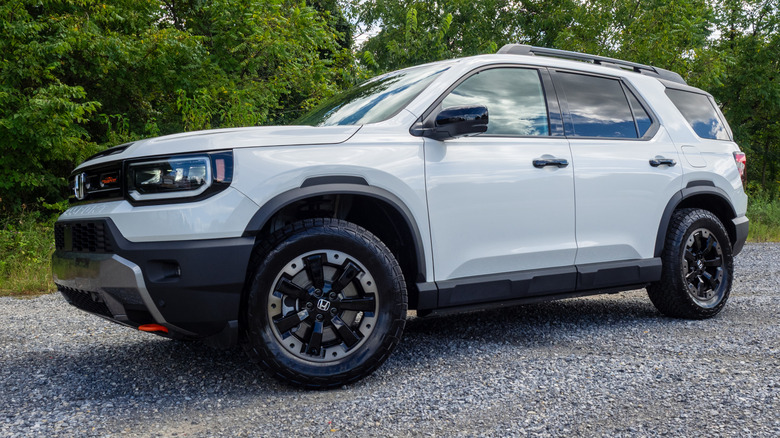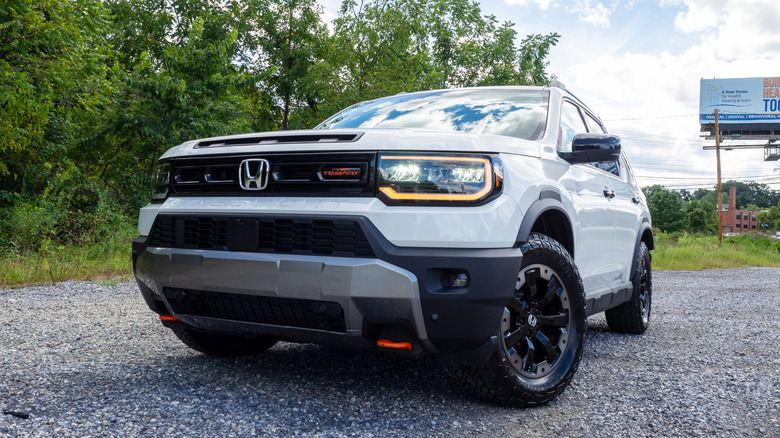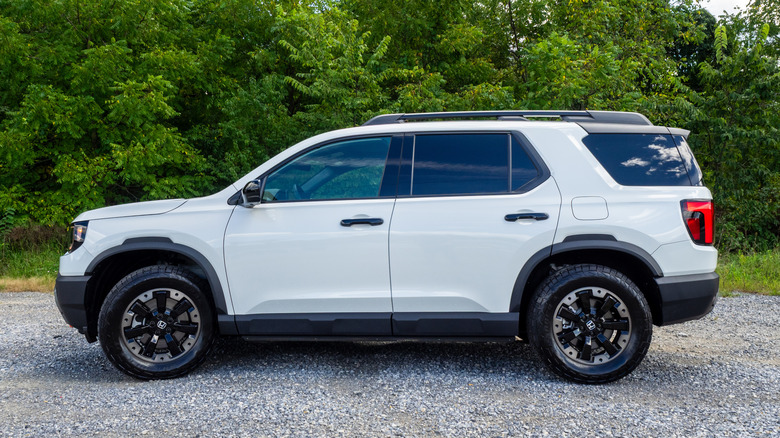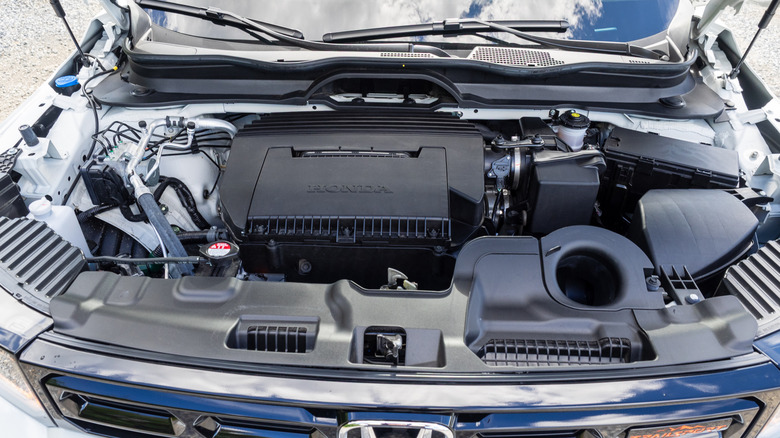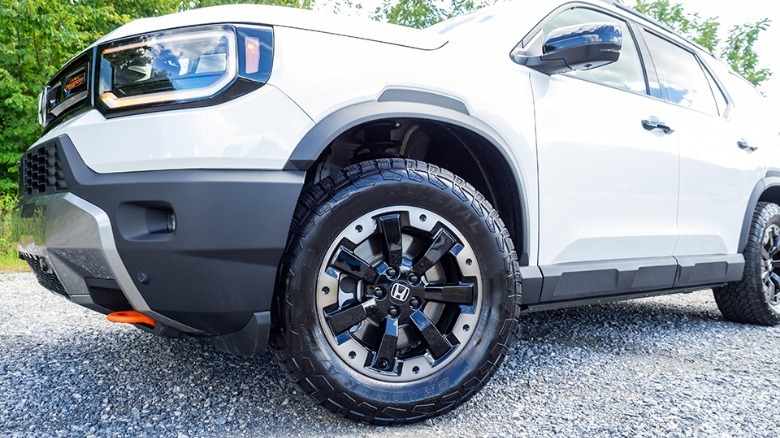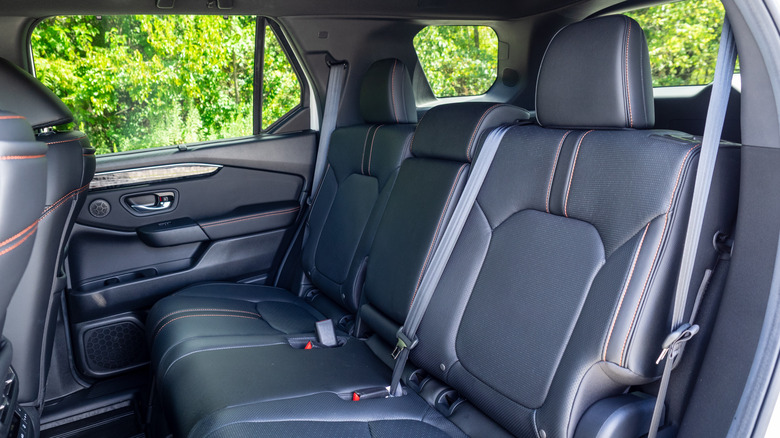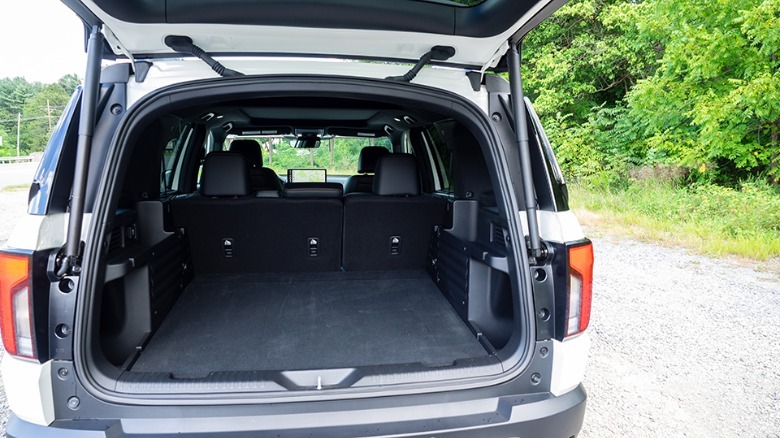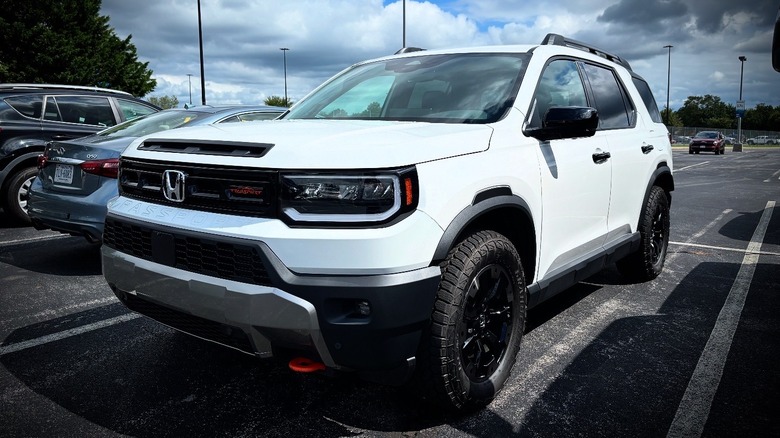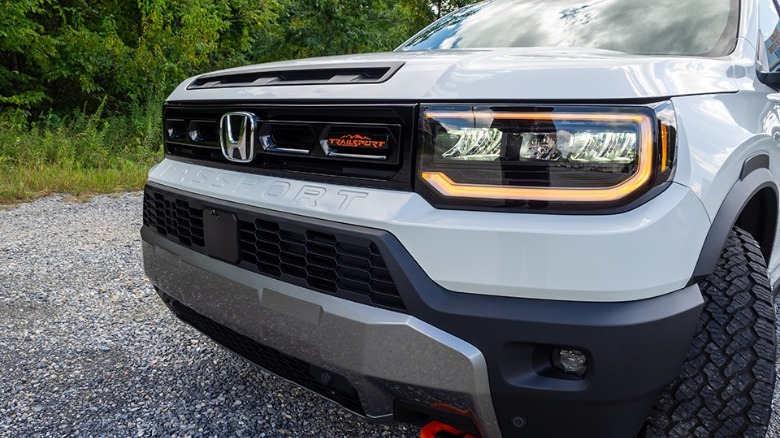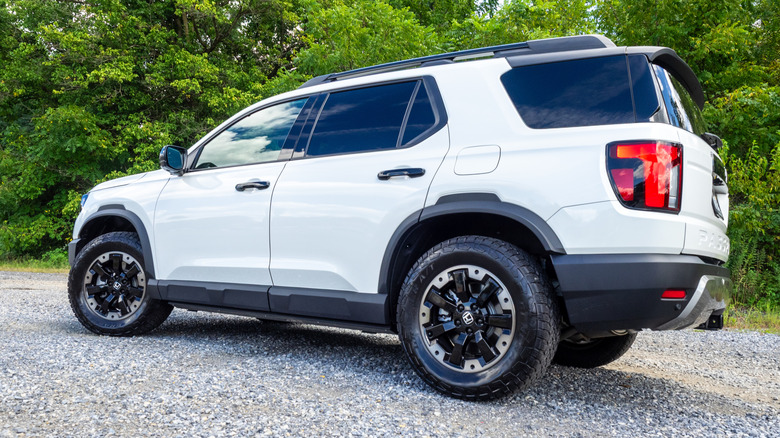Honda's New Passport TrailSport Is A Throwback In The Best Possible Way
Over 30 years ago, Honda entered the exploding SUV market with a little help from its then-partner, Isuzu. While Honda supplied Isuzu with vehicles like the Accord and Odyssey for rebadging, Isuzu bestowed upon its partner the Rodeo. The midsize SUV was given the name previously used on a variant of the Super Cub C70 motorcycle, Passport, with two generations built through 2002, after which point Honda allowed its Passport to expire to focus on the in-house engineered Pilot.
Sixteen years later, Honda renewed its Passport upon the bones of the third-generation Pilot, placing it between the smaller CR-V and its bigger sibling as a two-row, five-seat midsize crossover. For 2022, the third-gen Passport was among the first of the Tokyo-based automaker's crossover and truck lineup to offer the off-road-focused TrailSport trim, recalling its roots from the first two, Isuzu Rodeo-based generations.
Now, for 2026, Honda freshens the Passport again, this time with a boxier, more rugged appearance. And thus begins the first of two experiences I'll have with this updated midsize crossover, which starts with this review of a Platinum White-over-gray TrailSport I picked up at my local airport after spending some time in Louisville driving the 2026 Kia Sportage HEV. Let's see how well the more off-road-focused Passport handles the paved paths, shall we?
A lot of choice for the money
You'll be spoiled for choice when it comes to shopping for your 2026 Passport. The boxy midsize crossover comes in three base trims — RTL, TrailSport, and TrailSport Elite — with optional Towing (RTL only) or Blackout (all trims) packages. Pricing kicks off at $44,750 before the $1,450 destination charge:
- RTL: $44,750
- RTL Towing: $45,450
- RTL Blackout: $45,950
- TrailSport: $48,450
- TrailSport Blackout: $49,650
- TrailSport Elite: $52,450 ($54,350 as-tested including destination charge)
- TrailSport Elite Blackout: $53,650
The price range for the 2026 Passport places this Honda towards the middle of the midsize crossover pack, a group which includes its own Pilot, along with the Mazda CX-70 and Toyota 4Runner. Options like the $450 Platinum White Pearl our tester wore, $1,850 18-inch rugged alloys in either black or white, and a wide range of packages will push that final sticker price fairly close to $60,000, but that doesn't seem to stop most shoppers for this fourth-generation Passport.
According to Jessika Laudermilk, Honda National Auto Sales Assistant Vice President, the Passport "plays a pivotal role in [the] Honda lineup, with the highest conquest rate of any Honda SUV and more buyers under-40 than key competitors in its segment." The automaker adds that the TrailSport and TrailSport Elite trims accounted for 80% of all Passport sales through the second quarter of 2025 since the all-new midsize crossover's arrival back in February of 2025.
A backpack unlike any other
The 2026 Passport loses its predecessor's softer lines in exchange for what Honda calls its "Backpack Theme" styling. What that styling really reminds me of, though, is of the first two generations of this nameplate, matching up with the second-gen Passport the most. It's not quite as retro-modern as, say, the Ford Mustang, but the SUV harkens back to the boxy, brawny styling of the mid-1980s through the early 1990s before aerodynamics softened everything up. Based on appearance alone, it looks ready for a week of overlanding in the woods or the desert.
So, what is this "backpack business" all about, then? Per Honda, the styling is meant to evoke a backpacker, beginning with blacked-out roof rails and — behind the buffed-up C-pillar — matching blacked-out cargo bay. If you look at the profile of the Passport just so, especially from that C-pillar back, you can make out the "backpack" in question.
That rear treatment (which includes a resin garnish near the roof to allow leaning of tall items without damaging the paint), as Honda says, provides for "increased cargo flexibility with backpack-like functionality" (which we'll get into later). Either way, overall the SUV is quite easy on the eyes, especially with colors like Sunset Orange, Sonic Gray Pearl, and Modern Steel Metallic bringing out different personalities.
Climbing mountains on all fours
The previous Passport featured the 3.5-liter V6 used in the last-generation Pilot and the current Ridgeline and Odyssey. This time around, it's the updated 3.5-liter V6 — shared with the current generation Pilot — and linked to Honda's in-house 10-speed automatic (also shared with the Pilot), sending 285 horsepower (five more than the last generation) and 262 lb-ft of torque (same as before) exclusively to all four 18-inch wheels via the i-VTM4 all-wheel drive system (that was an option on the previous-generation Passport). Those wheels are wrapped in wide, 31-inch General Tire Grappler A/Ts designed and engineered specifically for the Passport in partnership between Honda and General Tire.
A beefed-up rear-drive unit with multi-link suspension plus front MacPherson struts promise the ability to conquer nearly any mountain, as well as the paved and unpaved roads leading to them. Fuel economy isn't too shabby against the majority of the Passport's competition, amounting to an EPA-estimated 20 combined mpg (18 city/23 highway), though the best I could do was 16.8 mpg over 140 miles of — mostly in-town — driving.
Tons of tech, with one glaring omission
While the 2026 Honda Passport's looks may throw back to those halcyon days of the 1990s, its tech packages are firmly planted in the middle of the 2020s. The driver and front passenger are greeted by a 10.2-inch driver information display and a 12.3-inch center touchscreen; the latter supports wireless Apple CarPlay and Android Auto, plus Google Built-In, HD Radio, a 5G Wi-Fi hotspot, and a standard nine-speaker stereo system (a 12-speaker Bose system is available only on the TrailSport Elite).
What isn't available, though, is SiriusXM satellite radio. In fact, newer Honda and Acura models don't have this feature at all, largely because smartphones can offer nearly the same experience via the SiriusXM app (not to mention all of the other streaming services one can employ for audible content). Honda/Acura aren't alone in this action, either, as Tesla, Rivian, and Vinfast all opted to do the same. Whether other automakers follow suit is just a matter of time and economics.
On the safety front, the automaker's Honda Sensing safety and driver-assist suite comes with upgrades and a few new additions for the 2026 Passport. Among the new features are traffic jam assist, traffic sign recognition, hill descent control, and driver attention monitoring. Updated features include collision mitigation braking, forward-collision warning, road departure mitigation, and lane-keeping assist with lane-departure warning. Throw in eight airbags and a stronger structure with improved collision absorption and dispersion, and you have one safe ride for you and yours.
Ram-like rear legroom in a small package
One of the benefits of being based on the same Global Light Truck Platform as the Honda Pilot (that also provides the foundation for the current-generation Ridgeline, if you're curious) is that the 2026 Passport can offer plenty of room for both cargo and people. And this is no more apparent than for the three lucky rear occupants: legroom for them increased over an inch from the previous Passport to 40.9 inches. That alone puts the midsize crossover ahead of the Subaru Outback (39.5 inches), Jeep Grand Cherokee (38.2 inches), and the all-new Toyota 4Runner (a paltry 34.8 inches). That's practically Ram 1500 Crew Cab-esque (45.2 inches, by the by) in this class.
Speaking of comfort, occupants can enjoy seating in either cloth/leather (RTL), cloth/leatherette (TrailSport) or perforated leather (TrailSport Elite), plus standard heated and power-adjustable front seats, tri-zone climate control, and a leather-wrapped steering wheel. Upper trims up the ante with heated and ventilated front seats, a heated steering wheel, heated rear seats, and a panoramic sunroof.
With the 60/40-split rear bench seat backs upright, there's 44 cu-ft of trunk space to work with. Set those backs down, and that expands to 83.8 cu-ft, enough to fit two full-size adult mountain bikes with the front wheels removed, according to Honda. The cargo floor and built-in ledge, plus large side storage bins and cubbies, making packing the Passport for the big adventure easy to do, and that's before adding in the Class III towing gear (allowing the Honda to tow up to 5,000 pounds) and whatever space or storage option you can put on the roof.
On the road with my Passport in my hand
While I'll focus on this midsize crossover's off-road prowess down at Honda's off-road training facility in North Carolina later, for now it's more about what it's like to live with the new mountain man away from the muddy and rocky trails. The actual everyday life, if you will. And that experience began upon leaving my local airport in Roanoke, Virginia to head home about 40 minutes southwest along the commonwealth's notorious I-81.
Once out of the economy lot, the first thing I did was put the Passport into Sport mode to quickly thread the needle through the heavy traffic around Roanoke leading out to I-81, where more of the same would await me until I took my last exit to home. Combined with its sportier handling and that small — but always welcome — uptick in horses going through the 10-speed, I had no problems getting out of the way to where I needed to be, leaving things up to the adaptive cruise control as soon as it was safe to do so while dropping the drive mode to either Eco or Normal as needed. The upgraded suspension and stiffer body construction also made driving around my usual, curvier test/photography route a breeze, too.
Other things I liked included the placement of the button for the Passport's surround-view camera system — it's at the end of the windshield wiper stalk; a smart choice I think all automakers should adopt — and the ventilated front seats, a welcome respite from the fading summer heat. As for the drawbacks, the fuel economy wasn't too hot as previously stated (but only because I spend most of my driving in-town), the all-terrain tires were noisy no matter which paved route I took, the rubber floor mats were too slick for even my work-safe shoes to handle, and the lack of SiriusXM was disappointing.
2026 Honda Passport verdict
But those minuses didn't detract too much from my time with the Passport overall. While my verdict as far as the legitimacy of its off-roading skills go is still to come, as far as an everyday vehicle matters, the midsize crossover is perfect for Honda fans seeking a rugged machine above the CR-V, but not as big as the Pilot. For everyone else, it's a matter of whether the song of nature sings in their hearts. If not, midsize competitors like the more street-centric Hyundai Palisade, Nissan Murano, or Mazda CX-70 would be right for them.
Just over three decades ago, Honda entered the SUV arena with a little help from Isuzu and Subaru by slapping the Passport name on Isuzu's own Rodeo down in Indiana. A fine start, to be sure, one that would set the precedent for Honda's off-road aspirations beyond the motorcycles, ATVs, and side-by-sides already tearing it up around the world with the famed "H" badge. Just over three decades later, the Passport fully returns to its roots, though as a unibody machine comfortable nearly anywhere it goes this time, and one that's uniquely Honda's.
